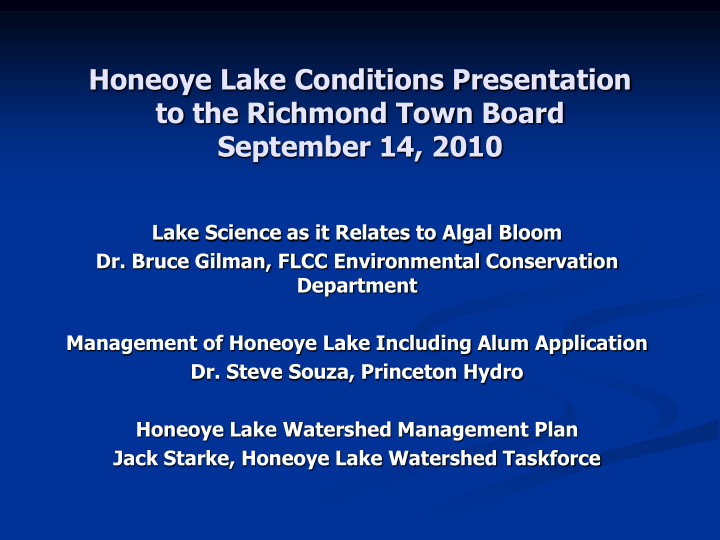



Honeoye Lake Conditions Presentation to the Richmond Town Board September 14, 2010 Lake Science as it Relates to Algal Bloom Dr. Bruce Gilman, FLCC Environmental Conservation Department Management of Honeoye Lake Including Alum Application Dr. Steve Souza, Princeton Hydro Honeoye Lake Watershed Management Plan Jack Starke, Honeoye Lake Watershed Taskforce
Who Manages Honeoye Lake? • NYS owns the lake • NYS-DEC is proactive in fishery management • NYS-DEC not proactive in lake management- regulatory only • State encourages lake management through grants • Towns of Canadice & Richmond • Honeoye Valley Association (1985) and predecessors • HLWTF formed in 1998 with watershed towns and HVA as voting members and supported by technical professionals
Honeoye Lake Watershed Management Plan Available at www.co.ontario.ny.us/planning/honeoye_lk.htm Developed by HLWTF under an Environmental Protection Fund grant from NYS Objectives To improve the water quality of Honeoye Lake To protect the Honeoye Lake Watershed’s natural resources To improve water-dependent recreational opportunities Approach & Purpose Science Based Environmentally Sound Improve chance of follow- on grants from NYS Results Extensive Compilation Scientific Data for Lake and Watershed Review of Local Law and their Effect on Water Quality Prioritized List of 76 Action Items
Highest Priority Action Items (19/76) 6.1.1: Wetland Restoration 6.1.2: Riparian Zone Management 2. Conduct field survey to identify and prioritize the most severely eroding streambanks and shorelines. Received grant 3. Where feasible, restore severely eroding streambanks and shorelines 4. Identify opportunities whereby stormwater management structures could be installed or stormwater bio-treatment areas could be constructed
Highest Priority Action Items (19/76) contd. 6.2.1: General Watershed Education 5. Educate residents on a “lake - friendly” lawn program to reduce nutrient input to the lake and perform survey of resident practices. Provide & promote use of zero phosphorus fertilizer. 6. Educate riparian property owners about proper management of streambanks and shoreline to minimize erosion. 8. Conduct training session for highway superintendents on recommended BMPs for road maintenance. Develop a written inspection and maintenance plan intended for use by highway department employees for the efficient management and maintenance of highway-related facilities. 9. Conduct training session for highway superintendents on recommended winter road de-icing practices.
Highest Priority Action Items (19/76) contd. 6.3.1: Nutrients 14. Develop Macrophyte Management Plan according to DEC guidelines considering all forms of macrophyte management. 15.Manage excessive macrophytes with weed harvesting until the WMP is completed 16. Expand the tributary sampling program to assess the actual contribution of streams and direct drainage areas to the lake’s overall nutrient budget under baseline and storm conditions. 17. Evaluate nutrient sources from highways, shoreline and streambanks. 18. Institute a monitoring program to evaluate the effectiveness and longevity of the alum treatment performed in 2006-2007.
Highest Priority Action Items (19/76) contd. 6.3.2: Onsite Wastewater Systems (Septic) 6.3.3: Forestry 27. Adopt Timber Harvest Regulations at the town level. Require pre-harvest planning and project inspection by a trained inspector. 6.3.4: Streambank/Shoreline Erosion 30. Maintain lake outlet weir. 31. Adopt municipal land use regulations to minimize peak flows in watershed streams and avoid shoreline erosion.
Highest Priority Action Items (19/76) contd. 6.3.5: Development 34. Municipalities recognize Phase II Stormwater Regulations within local laws and/or adopt the full NYS Sample Local Law to minimize erosion. 35. Planning boards review of the adequacy of municipal land use regulations to minimize erosion. 36. Municipalities evaluate current minimum setback and bulkhead/breakwall standards for new structures along the shoreline.
Highest Priority Action Items (19/76) contd. 6.3.6: Recreational Uses 6.3.7: Agriculture 6.3.8: Pesticides 6.3.9: Salt Usage and Storage 6.3.10: Spills 6.3.11: Bulk Storage Facilities 6.3.12: Landfills, Dumps and Inactive Hazardous Waste Sites 6.3.13: Mined Lands
Reasonable Expectations • Action Items Address Potential Threats to Lake Water Quality • No Silver Bullet • Shallow Lake Imposes Limitations on Water Quality V-Factor / Phosphorus Honeoye Conesus 30 Otisco Phosphorus (ug/l) 25 Cayuga Keuka 20 R 2 = 0.58 Hemlock 15 Owasko 10 Canandaigua Seneca 5 Skaneateles 0 Canadice 1 2 3 4 5 V-Factor = Mean Depth(m)/Cube Root(Volume(km 3 ))
Recommend
More recommend